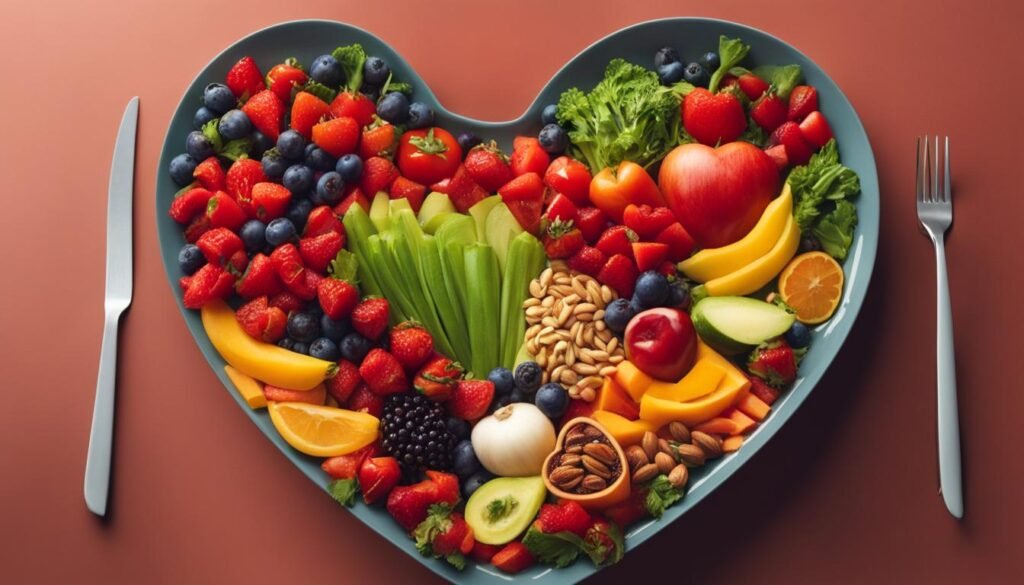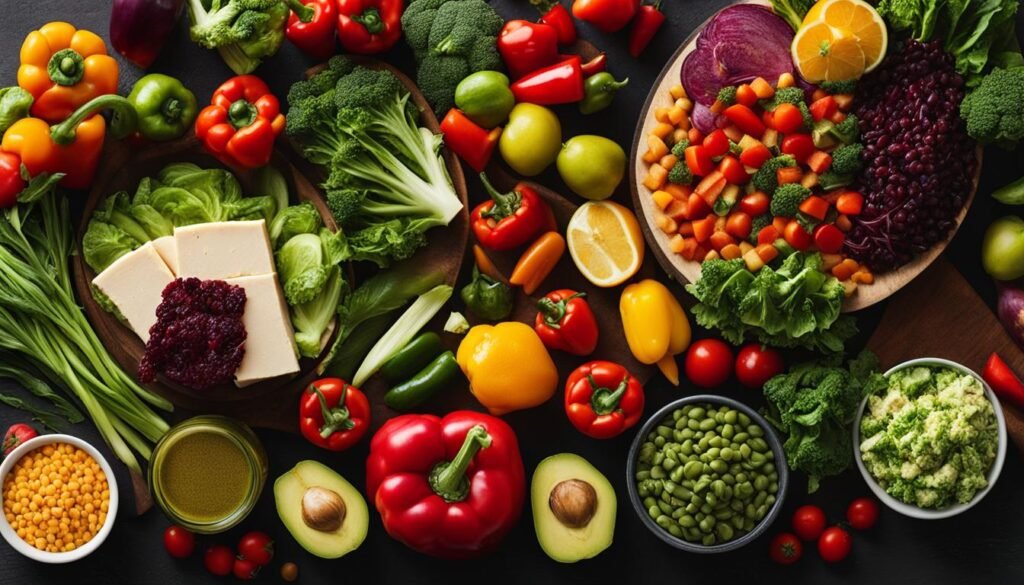Get our FREE E-Book HERE - 120 TIPS for Losing Weight & Bonus Tips for Postpartum Weight Loss & Dad’s Postpartum Experience
The Flexitarian Diet Guide: Balance Meat & Veggies

Welcome to our comprehensive guide on the Flexitarian Diet! If you’re looking for a flexible eating plan that allows you to balance the consumption of meat and vegetables, this article is for you. The Flexitarian Diet, created by dietitian Dawn Jackson Blatner, offers the benefits of vegetarian eating while still incorporating some animal products. It encourages a focus on plant-based foods, with meat and other animal products consumed in moderation.

In this guide, we’ll take you through the core principles of the Flexitarian Diet and provide a beginner’s understanding of what it entails. We’ll also explore the nutritional flexitarian diet benefits, including its impact on heart health, weight management, and the prevention and management of type 2 diabetes.
Curating a flexitarian food list and meal planning can seem overwhelming, but don’t worry – we’ve got you covered! You’ll find practical meal plan ideas and recipe suggestions that strike a balance between meat and veggies. Plus, we’ll discuss effective weight loss strategies within the flexitarian framework.
While the Flexitarian Diet offers numerous health benefits, it also has a positive environmental impact. By reducing meat intake, you can contribute to the planet’s well-being and resource sustainability.
Throughout this guide, we’ll address common challenges faced by flexitarians and provide tips for overcoming them. From managing nutrient deficiencies to navigating social situations and dining out, we’ve got the information you need to succeed on your flexitarian journey.
Let’s dive into the details of the Flexitarian Diet and discover how you can achieve a balanced and sustainable lifestyle that prioritizes your health and the planet. Are you ready? Let’s get started!
A Beginner’s Understanding: What is a Flexitarian Diet?
So, what is a flexitarian diet? It is a flexible eating plan that emphasizes a predominantly plant-based approach while allowing for moderate consumption of meat and other animal products. It offers the best of both worlds by combining the health benefits of a vegetarian diet with the flexibility to include animal protein when desired.
Origin and Philosophy of Flexitarianism
The concept of flexitarianism was introduced by registered dietitian Dawn Jackson Blatner. She coined the term to describe a balanced dietary approach that prioritizes plant-based foods while still allowing for occasional flexibility in the consumption of animal products. This approach is rooted in the belief that a predominantly plant-based diet can have significant health and environmental benefits.
Core Principles of a Flexitarian Lifestyle
The core principles of a flexitarian lifestyle revolve around incorporating more plant-based foods into your daily eating habits. This includes increasing your intake of fruits, vegetables, whole grains, legumes, and plant-based proteins. Flexitarians prioritize minimally processed, whole foods and aim to reduce their reliance on highly processed and high-fat animal products. The flexibility aspect of the diet allows for occasional consumption of meat, poultry, fish, or dairy products, giving individuals the freedom to make choices that align with their personal preferences and health goals. The emphasis is on balance and moderation.
How Flexitarianism Compares to Vegetarianism and Veganism
Flexitarianism is often viewed as a more flexible alternative to vegetarianism and veganism. While vegetarians exclude meat and sometimes other animal products from their diet, flexitarians have the freedom to include small amounts of animal protein. On the other hand, veganism is a lifestyle that avoids all animal products, including meat, dairy, eggs, and honey. Flexitarianism allows for a gradual transition and can be seen as a stepping stone toward a vegetarian or vegan lifestyle if desired. It offers a middle ground by promoting a plant-centric approach while providing the flexibility to enjoy animal products in moderation.
Nutritional Benefits of Flexitarian Diet
The benefits of flexitarian diet can contribute to your overall health and well-being. By incorporating more plant-based foods into your meals while still allowing for occasional meat consumption, you can enjoy a balanced and nutritious eating plan. In this section, we will explore three key areas where the flexitarian diet can have a positive impact on your health: heart health, weight management, and the prevention and management of type 2 diabetes.
Promoting Heart Health and Reducing Disease Risk
One of the significant benefits of the flexitarian diet is its potential to promote heart health and reduce the risk of cardiovascular diseases. Research has shown that plant-based diets, which emphasize fruits, vegetables, whole grains, nuts, and legumes, can help lower blood pressure, reduce cholesterol levels, and decrease the risk of heart disease and stroke. By incorporating more plant-based meals into your diet, you can support a healthy heart and improve your overall cardiovascular health.
Additionally, the flexitarian diet encourages the consumption of lean proteins, such as fish and poultry, in moderation. These protein sources provide essential nutrients like omega-3 fatty acids, which are beneficial for heart health. By choosing lean meats and reducing the intake of red and processed meats, you can further support a heart-healthy diet.
Flexitarian Diet and Weight Management Benefits
If you’re looking to manage your weight effectively, the flexitarian diet can be a valuable tool. With its emphasis on plant-based foods, the flexitarian diet tends to be lower in calories and higher in fiber compared to a traditional meat-heavy diet. Consuming a diet rich in fiber can help you feel fuller for longer, reducing the likelihood of overeating and aiding in weight management.
Additionally, plant-based foods are typically nutrient-dense, meaning they provide essential vitamins, minerals, and antioxidants while being relatively low in calories. By focusing on these foods, you can ensure that you’re nourishing your body while also maintaining a healthy weight.
Type 2 Diabetes: Prevention and Management Through Diet
For individuals at risk of or already diagnosed with type 2 diabetes, the flexitarian diet can be a beneficial approach to diet management. Studies have shown that plant-based diets, like the flexitarian diet, can help lower the risk of developing type 2 diabetes and improve blood sugar control in individuals with the condition.
The flexitarian diet’s emphasis on whole, unprocessed foods, including fruits, vegetables, whole grains, legumes, and nuts, can help regulate blood sugar levels and improve insulin sensitivity. Additionally, reducing the intake of red and processed meats, as encouraged by the flexitarian diet, can further support diabetes management.

Flexitarian Diet
The flexitarian diet is a flexible and sustainable eating plan that promotes a balance between plant-based foods and moderate consumption of meat and other animal products. It offers a practical approach for individuals who want to incorporate more plant-based meals into their diet without completely eliminating meat.
The core principles of the flexitarian diet involve prioritizing whole, unprocessed plant-based foods such as fruits, vegetables, whole grains, legumes, nuts, and seeds. These foods provide essential nutrients, fiber, and antioxidants that support overall health and well-being.
By including a variety of plant-based foods, the flexitarian diet ensures a rich and diverse nutrient intake. This can help to reduce the risk of chronic diseases such as heart disease, obesity, and certain types of cancer.
Flexitarian meal planning is flexible and adaptable to individual preferences and dietary needs. It allows for moderate consumption of meat and other animal products, which can provide additional nutrients such as protein, iron, and vitamin B12.
When following the flexitarian diet, it’s important to choose high-quality, sustainably sourced meat and animal products. This supports ethical and environmentally conscious food choices.
To help you incorporate the flexitarian diet into your lifestyle, here are some recipe ideas:
- Vegetable stir-fry: Sauté your favorite vegetables in olive oil and garlic, and toss with a flavorful sauce made from low-sodium soy sauce, ginger, and honey.
- Chickpea curry: Simmer chickpeas and vegetables in a fragrant blend of spices, coconut milk, and tomato sauce for a hearty and delicious plant-based meal.
- Grilled salmon with roasted vegetables: Season a salmon fillet with herbs and spices, then grill until cooked through. Serve with a side of roasted vegetables like broccoli, carrots, and bell peppers.
- Quinoa salad: Combine cooked quinoa, diced vegetables, herbs, and a zesty dressing made with lemon juice, olive oil, and Dijon mustard for a refreshing and nutritious salad.
By incorporating these recipe ideas and meal planning tips, you can enjoy the flexibility and health benefits of the flexitarian diet while still savoring delicious and satisfying meals.
Curating Your Flexitarian Diet Food List
In order to successfully follow a flexitarian diet and incorporate more plant-based foods into your meals, it’s important to curate a well-rounded flexitarian diet food list. This will ensure that you have a variety of nutritious options to choose from and can make informed decisions about what to include in your meals.
Plant-Based Foods to Embrace
One of the key principles of a flexitarian diet is to focus on plant-based foods. These foods form the foundation of your meals and provide essential nutrients and fiber. Include a variety of the following plant-based foods in your flexitarian diet:
- Fruits and vegetables: Incorporate a wide range of colorful fruits and vegetables into your meals. They are packed with vitamins, minerals, and antioxidants that support overall health.
- Legumes: Legumes such as beans, lentils, and chickpeas are excellent sources of plant-based protein, fiber, and iron. They can be used in soups, stews, salads, and even as a meat substitute in tacos or burgers.
- Whole grains: Opt for whole grains like quinoa, brown rice, whole wheat bread, and oats. These provide complex carbohydrates, fiber, and important nutrients.
- Nuts and seeds: Incorporate a variety of nuts and seeds such as almonds, walnuts, chia seeds, and flaxseeds into your diet. They provide healthy fats, protein, and other important nutrients.
Animal Products: Understanding Moderation
While a flexitarian diet focuses on plant-based foods, it also allows for the moderate consumption of animal products. When including animal products in your meals, it’s important to prioritize quality and portion control. Choose lean, organic, or sustainably sourced options whenever possible.
What to Limit: Decreasing Processed Food Intake
Reducing processed food intake is an important aspect of a healthy flexitarian diet. Processed foods are often high in added sugars, unhealthy fats, and sodium. By limiting your intake of processed foods, you can prioritize whole, nutrient-dense foods that support your overall well-being. Choose whole foods whenever possible and minimize your consumption of processed snacks, sugary beverages, and pre-packaged meals.

Flexitarian Meal Plan Ideas
Ready to start planning your flexitarian meals? Here are some delicious and nutritious ideas to get you started:
Quick and Nutritious Breakfast Options
- Flexitarian Overnight Oats: Prepare a jar of overnight oats with rolled oats, plant-based milk, chia seeds, and your favorite toppings like berries and nuts. Leave it in the fridge overnight for a quick and filling breakfast in the morning.
- Veggie-packed Omelette: Whip up a fluffy omelette with eggs or substitute with tofu, and load it with a variety of sautéed vegetables like spinach, peppers, and mushrooms.
- Flexitarian Smoothie Bowl: Blend together a mix of frozen fruits, leafy greens, plant-based protein powder, and your choice of liquid. Top it with granola, sliced fruits, and a drizzle of nut butter for a nutrient-packed bowl.
Lunches that Embrace Plant Diversity
- Rainbow Salad: Create a vibrant salad with a variety of colorful vegetables such as carrots, cucumbers, cherry tomatoes, bell peppers, and avocado. Add a protein source like grilled chicken or chickpeas and toss it with your favorite dressing.
- Flexitarian Buddha Bowl: Build a nourishing bowl with a base of quinoa or brown rice, and top it with roasted vegetables, leafy greens, cooked beans, and a sprinkle of seeds. Drizzle it with a flavorful dressing for a satisfying meal.
- Sweet Potato and Black Bean Tacos: Fill whole-grain tortillas with roasted sweet potatoes, black beans, salsa, and a dollop of Greek yogurt. Serve it with a side of mixed greens and your favorite salsa for added freshness.
Dinners: Balancing Meat and Veggies
“A flexitarian dinner is all about finding the right balance between meat and vegetables. Here are some ideas to inspire your evening meals:”
- Grilled Salmon with Roasted Vegetables: Grill a piece of salmon and serve it with a side of colorful roasted vegetables like Brussels sprouts, carrots, and zucchini. Sprinkle it with fresh herbs and lemon juice for extra flavor.
- Flexitarian Stir-Fry: Sauté tofu or your choice of lean meat with an array of stir-fry vegetables like broccoli, bell peppers, snap peas, and mushrooms. Add a homemade stir-fry sauce and serve it over brown rice or noodles.
- Vegan Lentil Curry: Cook up a fragrant lentil curry with spices like turmeric, cumin, and ginger. Add a variety of vegetables like spinach, cauliflower, and bell peppers for a nutritious and satisfying meatless dinner.
These meal plan ideas are just a starting point to help you create delicious, well-balanced meals on your flexitarian journey. Remember to experiment with different ingredients and flavors to keep your meals exciting and enjoyable.
Flexitarian Weight Loss Strategies
If you’re looking to lose weight on a flexitarian diet, there are several strategies you can implement to maximize your success. These tips and recommendations will help you achieve your flexitarian weight loss results while enjoying the benefits of a flexitarian lifestyle.
- Focus on Plant-Based Foods: Make sure the majority of your meals consist of fruits, vegetables, legumes, and whole grains. These foods are rich in fiber and nutrients, and they can help you feel full and satisfied.
- Portion Control: Be mindful of your portion sizes, even when it comes to plant-based foods. While they are nutritious, they still contain calories, and consuming too much can hinder your weight loss efforts. Use measuring cups or a food scale to keep track of your portions.
- Limit Processed Foods: Processed foods often contain added sugars, unhealthy fats, and empty calories. Minimize your intake of processed snacks, sweets, and beverages, and instead opt for whole, unprocessed alternatives.
- Incorporate Lean Proteins: When consuming animal products, choose lean protein sources such as skinless poultry, fish, and legumes. These options are lower in calories and saturated fat compared to fattier meats.
- Practice Mindful Eating: Slow down and savor each bite during mealtimes. Pay attention to your hunger and satiety cues, and stop eating when you’re comfortably full. Mindful eating can prevent overeating and promote better digestion.
- Stay Hydrated: Drink plenty of water throughout the day. Sometimes, thirst can be mistaken for hunger, leading to unnecessary snacking. Plus, staying hydrated can support metabolism and overall well-being.
- Engage in Regular Physical Activity: Combine your flexitarian diet with regular exercise to enhance weight loss results. Aim for at least 150 minutes of moderate-intensity aerobic activity per week, along with strength training exercises.

Remember, weight loss is a gradual process, and it’s important to be patient with yourself. The flexitarian diet offers a sustainable approach to weight management, allowing you to enjoy a variety of foods while achieving your health goals.
Adopting a Flexitarian Lifestyle for Environmental Impact
In addition to the individual health benefits, adopting a flexitarian lifestyle also has a positive environmental impact. By reducing meat intake and embracing plant-based foods, you can contribute to a more sustainable and eco-friendly future.
How Reducing Meat Intake Can Benefit the Planet
One of the main environmental benefits of the flexitarian diet is the reduction of greenhouse gas emissions. Livestock farming, particularly the production of beef and lamb, contributes significantly to greenhouse gas emissions, including methane and nitrous oxide, which are more potent than carbon dioxide. By reducing meat consumption and choosing more plant-based options, you can help mitigate climate change and reduce your carbon footprint.
According to a study published in the journal Nature, shifting towards a flexitarian diet can significantly reduce greenhouse gas emissions by up to 50%. This reduction is equivalent to removing 1.5 billion cars from the road. By making conscious diet choices, you can directly contribute to the fight against climate change.
Resource Sustainability through Diet Choices
Another critical aspect of the flexitarian lifestyle is resource sustainability. A flexitarian diet emphasizes the consumption of plant-based foods, which require fewer natural resources compared to meat production.
Meat production requires vast amounts of water, land, and feed for livestock, which puts a strain on natural resources. By reducing meat intake and diversifying your diet with fruits, vegetables, whole grains, and legumes, you can conserve water resources, reduce deforestation, and protect biodiversity.
Cooking Flexitarian Recipes at Home
When following a flexitarian diet, cooking delicious and nutritious meals at home is key. By preparing your own meals, you have control over the ingredients and can ensure they align with the principles of a flexitarian lifestyle. Here are some tips and guidance to help you get started with cooking flexitarian recipes at home:
1. Embrace Plant-Based Ingredients: Incorporate a variety of plant-based foods into your recipes. Fruits, vegetables, legumes, and whole grains are excellent options that can add flavor, nutrients, and variety to your meals. Explore different cuisines and experiment with new ingredients to keep your meals exciting and diverse.
2. Opt for Plant-Protein Sources: Substitute meat with plant-based protein sources like tofu, tempeh, seitan, or legumes in your recipes. These alternatives not only provide essential nutrients but also add texture and taste to your meals.
3. Make Friends with Spices and Herbs: Enhance the flavors of your dishes with herbs and spices. Fresh herbs like basil, cilantro, and rosemary can add depth to your recipes, while spices like cumin, paprika, and turmeric can elevate the taste profile. Experiment with different combinations to find your favorite flavor combinations.
4. Incorporate Meal Prep: Plan your meals in advance and dedicate some time to meal prep. This will not only save you time during busy weekdays but also make it easier to stick to your flexitarian diet. Chop vegetables, cook grains, and marinate protein sources in advance to have ingredients ready when you need them.
5. Don’t Be Afraid to Modify Recipes: Flexitarian cooking is all about flexibility. Feel free to modify recipes to fit your preferences and dietary needs. Substitute ingredients, adjust seasonings, and experiment with different cooking techniques to create dishes that suit your taste.
6. Get Inspired: Look for inspiration in cookbooks, food blogs, and online recipe databases. There are plenty of flexitarian recipe ideas available that can spark your creativity and help you expand your culinary horizons.
The Challenges of a Flexitarian Diet and How to Overcome Them
Following a flexitarian diet comes with its own set of challenges, but with the right strategies, you can overcome them and successfully incorporate this flexible eating style into your lifestyle. This section will address two key challenges commonly faced by individuals on a flexitarian diet – understanding and managing nutrient deficiencies, and navigating social situations and dining out.
Understanding and Managing Nutrient Deficiencies
One of the main concerns when following a flexitarian diet is the risk of nutrient deficiencies. Since flexitarians consume a primarily plant-based diet with limited meat and animal product intake, it’s important to ensure you’re meeting your nutritional needs.
To overcome this challenge, consider the following strategies:
- Focus on a variety of plant-based foods: Include a wide range of fruits, vegetables, whole grains, legumes, nuts, and seeds in your diet. This will help you obtain a diverse array of essential nutrients.
- Monitor nutrient levels: Regularly check and monitor your nutrient levels through blood tests. This can help you identify any deficiencies and take appropriate measures to address them.
- Consider supplementation: If you find it challenging to meet your nutrient needs through your diet alone, talk to a healthcare professional about appropriate supplementation. They can guide you on which nutrients may require supplementation based on your specific needs.
- Seek guidance from a registered dietitian: Consulting a registered dietitian can provide you with personalized dietary advice to ensure you’re meeting your nutritional requirements while following a flexitarian diet.
Navigating Social Situations and Dining Out
Social situations and dining out can present challenges for flexitarians. However, with some planning and communication, you can successfully navigate these situations without compromising your dietary choices.
Here are some tips to help you navigate social situations and dining out as a flexitarian:
- Communicate your dietary preferences: Let your friends, family, or dining companions know about your flexitarian lifestyle in advance. This gives them the opportunity to accommodate your dietary choices or suggest alternative options.
- Research restaurant menus beforehand: Before dining out, review the restaurant’s menu online and look for flexitarian-friendly options. Many restaurants now offer plant-based alternatives and vegetarian dishes that can be easily modified to fit a flexitarian diet.
- Opt for customized orders: Don’t hesitate to request modifications to dishes to suit your dietary preferences. Most restaurants are willing to accommodate special requests, such as swapping meat for plant-based protein or adding extra vegetables.
- Be prepared with portable snacks: If you’re unsure about the available options at an event or gathering, carry some portable flexitarian-friendly snacks with you. This way, you’ll have a backup in case there aren’t suitable food choices available.
By implementing these strategies, you can overcome the challenges of a flexitarian diet and continue to enjoy the many benefits it offers.
Conclusion
Congratulations on completing this comprehensive guide to the flexitarian diet! By now, you have gained a clear understanding of what the flexitarian diet is and how it can benefit your health, weight management, and the environment. Incorporating the principles of the flexitarian lifestyle into your own life can lead to numerous advantages, including improved heart health, reduced disease risk, and sustainable resource consumption.

Remember, the key to success with the flexitarian diet lies in finding the right balance between plant-based foods and animal products. Embrace a variety of fruits, vegetables, legumes, and whole grains, while enjoying meat and other animal products in moderation. By curating your flexitarian food list and planning your meals mindfully, you can ensure a nutritious and satisfying eating experience.
Though there may be challenges along the way, such as navigating social situations or managing nutrient deficiencies, don’t let them deter you from embracing the flexitarian lifestyle. Educate yourself about potential nutrient gaps and make informed choices to address them. Additionally, seek support from friends, family, or online communities to stay motivated and engaged.
Remember, the flexitarian lifestyle is about progress, not perfection. As you embark on your flexitarian journey, take it one step at a time and celebrate each small victory along the way. By adopting the flexitarian principles, you are making a positive impact on your own health and the health of the planet. So, go ahead and embrace this flexible and sustainable approach to eating – your body and the environment will thank you!
FAQ
What is the Flexitarian Diet?
The Flexitarian Diet is a flexible eating plan that aims to balance the consumption of meat and vegetables. It encourages a focus on plant-based foods, with meat and other animal products consumed in moderation.
Who created the Flexitarian Diet?
The Flexitarian Diet was created by dietitian Dawn Jackson Blatner as a way for people to enjoy the benefits of vegetarian eating while still incorporating some animal products.
How does the Flexitarian Diet differ from vegetarianism and veganism?
While vegetarianism and veganism eliminate or greatly reduce animal products, the Flexitarian Diet allows for moderate consumption of meat and other animal products, making it a flexible approach to plant-based eating.
What are the nutritional benefits of following a flexitarian diet?
Following a flexitarian diet can promote heart health, reduce the risk of diseases such as cardiovascular disease, support weight management, and help prevent and manage type 2 diabetes.
What should be included in a flexitarian diet food list?
A flexitarian diet food list should include a variety of fruits, vegetables, legumes, and whole grains as the foundation. It should also include moderate amounts of lean meats, poultry, fish, and dairy products.
Can you provide some flexitarian meal plan ideas?
Yes! Quick and nutritious breakfast options, lunches that embrace plant diversity, and dinner recipes that strike a balance between meat and vegetables are all great ideas for a flexitarian meal plan.
How can the Flexitarian Diet be used for weight loss?
The Flexitarian Diet can support weight loss by helping to control calorie intake and providing a balanced approach to nutrition. Making smart food choices and monitoring portion sizes are key strategies for weight loss on a flexitarian diet.
How does a flexitarian lifestyle contribute to environmental sustainability?
Adopting a flexitarian lifestyle can benefit the environment by reducing greenhouse gas emissions and conserving resources associated with meat production. Making conscious diet choices can contribute to overall resource sustainability.
Are there any flexitarian recipes available for cooking at home?
Absolutely! There are plenty of flexitarian recipes available that align with the principles of a flexitarian diet. These recipes offer a variety of options for incorporating plant-based foods and moderate amounts of meat and other animal products.
What challenges might arise when following a flexitarian diet, and how can they be overcome?
Nutrient deficiencies may arise when following a flexitarian diet, so it’s important to understand and manage them by planning balanced meals and considering appropriate supplementation. Navigating social situations and dining out may also require some additional thought and preparation.
Where can I get more information about the flexitarian diet. Any books you recommend?
Sure! Our pick is Mostly Plants: 101 Delicious Flexitarian Recipes from the Pollan Family by Tracy Pollan, Dana Pollan, Lori Pollan and Corky Pollan
Don’t let title or the cover fool you. This is not a meat free book. In fact our favorite recipe is Tandoori Chicken and Vegetable Sheet Pan Supper.

Don’t forget to check out our Resources page, which includes 7 different calculators you can use for FREE.
Download our FREE e-book HERE, which describes in detail 120 TIPS for Losing Weight & Bonus Tips for Postpartum Weight Loss & Dad’s Postpartum Experience




